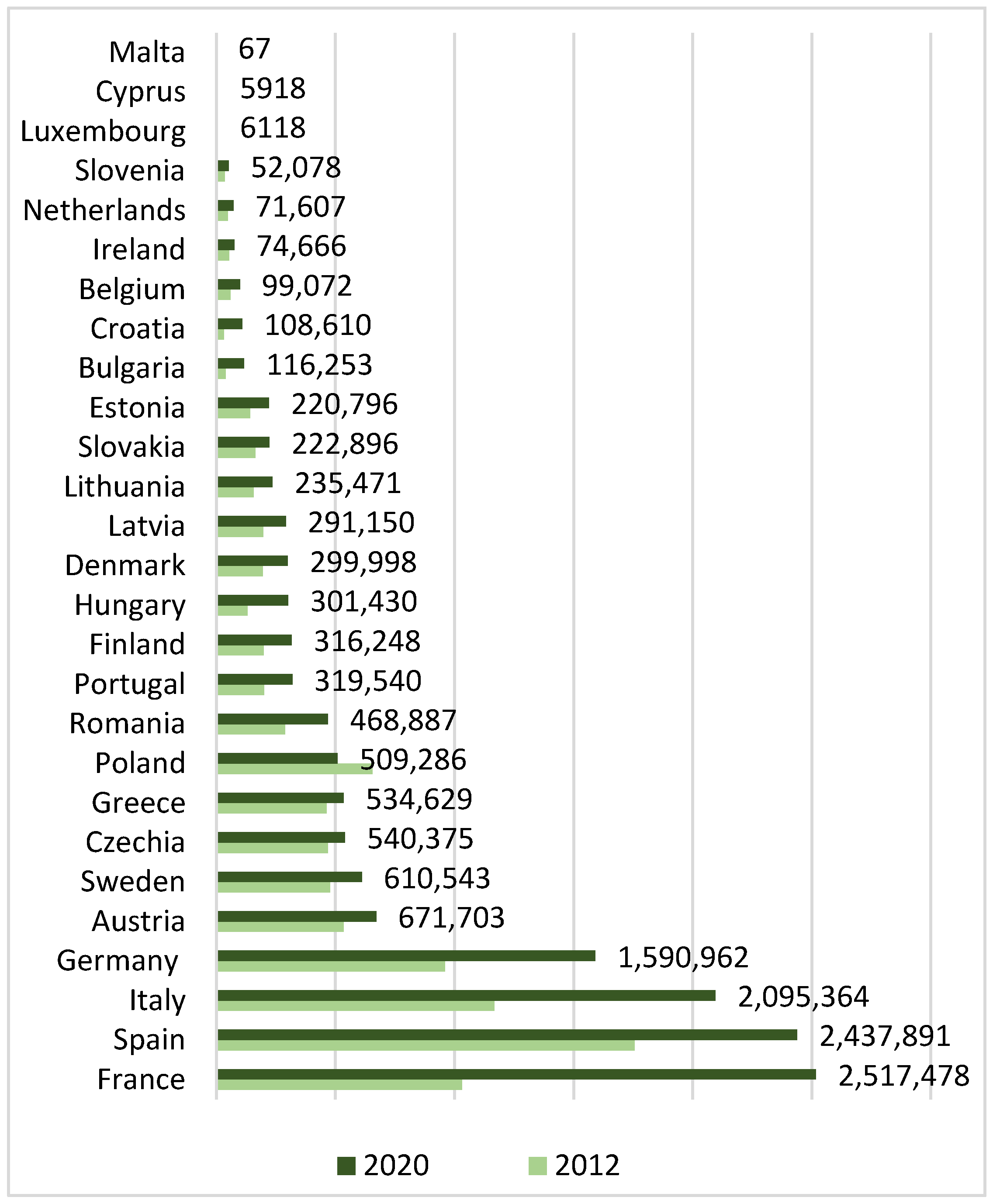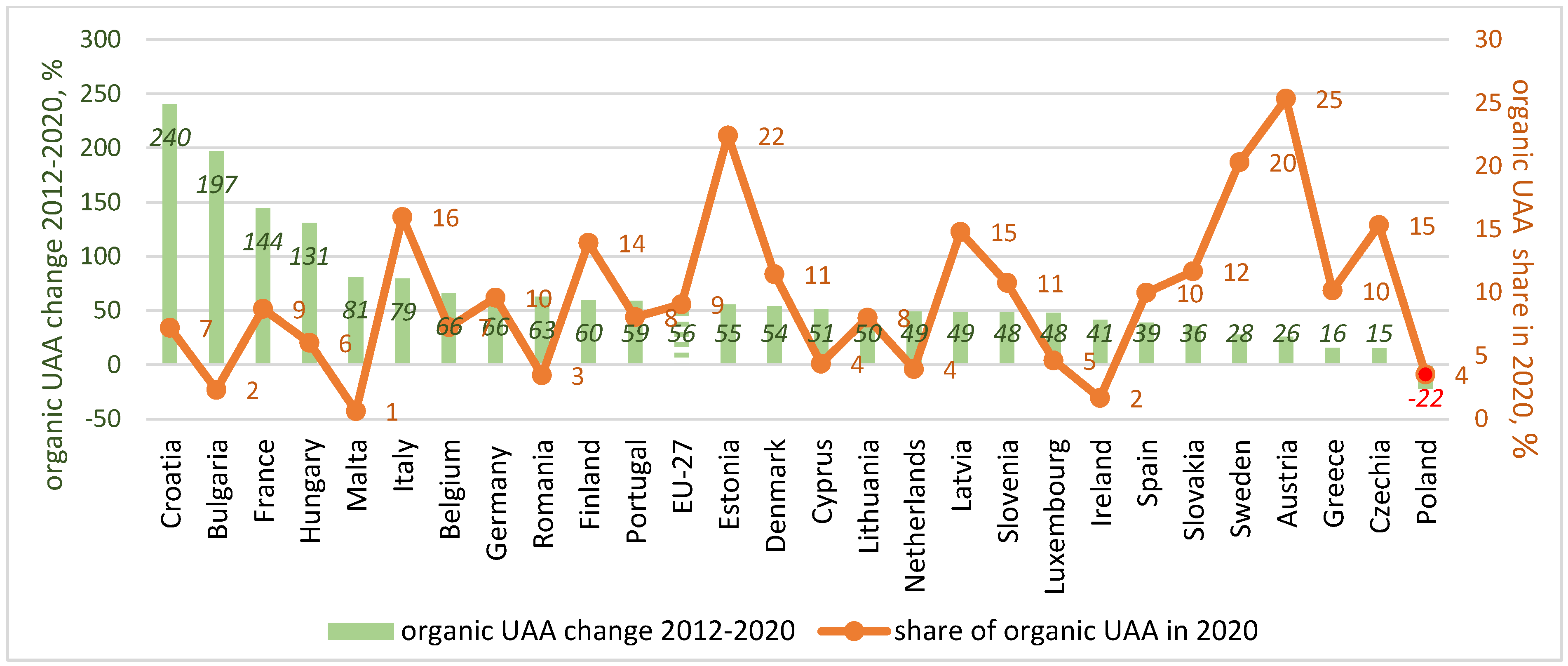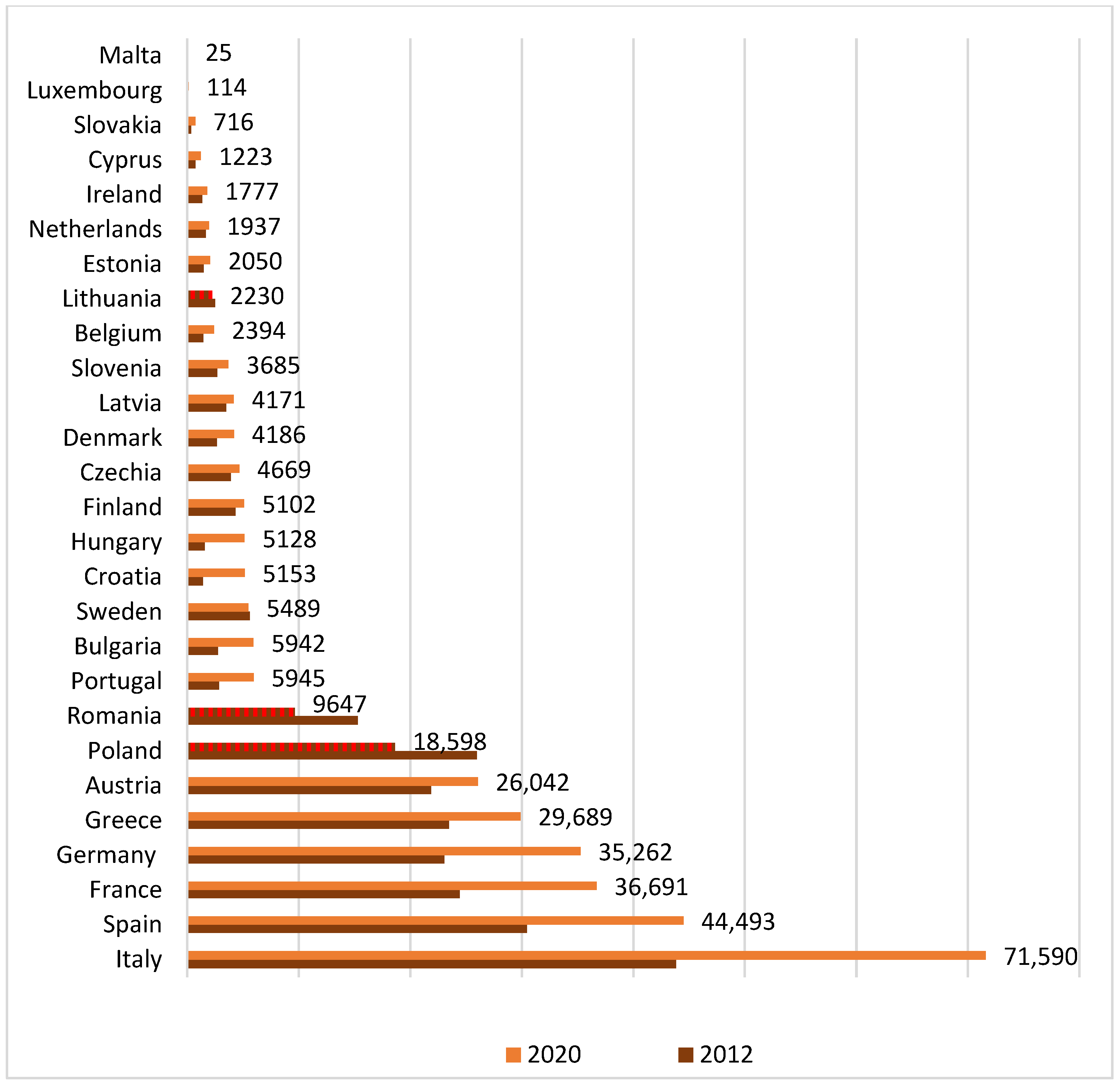Organic farms should, by definition, place particular emphasis on the protection of agricultural soils, landscape care and activities aimed at producing high-quality agricultural products. In Poland, its development strength largely depends on the presence of areas facing natural or other specific constraints (ANCs). Nearly ¾ of organic utilized agriculture area (UAA) is located in communes with a large share of them. Organic farms achieve lower production effects in comparison to conventional farms, and their disproportions also depend on the quality of natural farming conditions. In Poland, the personal competences of farmers are also an important determinant in joining organic farming.
- areas facing natural or other specific constraints (ANCs)
- EU CAP
- Farm Accountancy Data Network (FADN)
- organic farms
1. Introduction
2. Yields Gaps between Organic and Conventional Farming
3. The Direction of Organic Farming Development in the EU, including Poland



4. Natural Farming Conditions in Poland and the Development of Organic Farming Supported by the EU CAP

| Variable | Communes | |
|---|---|---|
| With a High Share of ANCs | Remaining | |
| Number of farms (thousands) | 620.6 | 631.4 |
| UAA (thousand ha), including: | 6705.4 | 7459.0 |
| arable lands (thousand ha) | 4807.8 | 6440.2 |
| permanent grasslands (thousand ha) | 1790.3 | 737.6 |



This entry is adapted from the peer-reviewed paper 10.3390/agriculture14020297
References
- FAO. Emissions Due to Agriculture. Global, Regional and Country Trends 2000–2018. FAOSTAT Analytical Brief 18; FAO: Rome, Italy, 2020.
- Gamage, A.; Gangahagedara, R.; Gamage, J.; Jayasinghe, N.; Kodikara, N.; Suraweera, P.; Merah, O. Role of organic farming for achieving sustainability in agriculture. Farming Syst. 2023, 1, 100005.
- Czyżewski, A.; Stępień, S.; Nowe Uwarunkowania Ekonomiczne Wspólnej Polityki Rolnej (WPR) Unii Europejskiej. Ekonomista, nr. 6. 2017. Available online: https://ekonomista.pte.pl/pdf-155585-82414?filename=Nowe%20uwarunkowania.pdf (accessed on 24 November 2023).
- Van der Zanden, E.; Verburg, P.H.; Schulp, C.J.E.; Verkerk, P.J. Trade-offs of European agricultural abandonment. Land Use Policy 2017, 62, 290–301.
- IPBES. Summary for Policymakers of the Global Assessment Report on Biodiversity and Ecosystem Services of the Intergovernmental Science-Policy Platform on Biodiversity and Ecosystem Services; IPBES Secretariat: Bonn, Germany, 2019.
- CBD. Global Biodiversity Outlook 5. Montreal. 2019. Available online: http://41.89.141.8/kmfri/handle/123456789/1609 (accessed on 24 November 2023).
- Zgłobicki, W.; Karczmarczuk, K.; Baran-Zgłobicka, B. Intensity and Driving Forces of Land Abandonment in Eastern Poland. Appl. Sci. 2020, 10, 3500.
- Pe’er, G.; Bonn, A.; Bruelheide, H.; Dieker, P.; Eisenhauer, N.; Feindt, P.; Hagedorn, G.; Hansurgens, B.; Herzon, I.; Lomba, A.; et al. Action needed for the EU Common Agricultural Policy to address sustainability challenges. People Nat. 2020, 2, 305–316.
- Koninger, J.; Panagos, P.; Jones, A.; Briones, M.J.I.; Orgiazzi, A. In deference of soil biodiversity: Towards an inclusive protection in the European Union. Biol. Conserv. 2022, 268, 109475.
- Lefebvre, M.; Espinosa, M.; Paloma Gomez, S.; Paracchini, M.L.; Piorr, A.; Zasada, I. Agricultural landscapes as multi-scale public good and the role of the Common Agricultural Policy. J. Environ. Plan. Manag. 2014, 58, 2088–2112.
- Jespersen, L.M.; Baggesen, D.L.; Fog, E.; Halsnæs, K.; Hermansen, J.E.; Andreasen, L.; Strandberg, B.; Sørensen, J.T.; Halberg, N. Contribution of organic farming to public goods in Denmark. Org. Agric. 2017, 7, 243–266.
- McGurk, E.; Hynes, S.; Thorne, F. Participation in agri-environmental schemes: A contingent valuation study of farmers in Ireland. J. Environ. Manag. 2020, 262, 110243.
- Boschiero, M.; De Laurentiis, V.; Caldeira, C.; Sala, S. Comparison of organic and conventional cropping systems: Asystematic review of life cicle assessment studies. Environ. Impact Assess. Rev. 2023, 102, 107187.
- Lee, S.K.; Choe, C.Y.; Park, H.S. Measuring the environmental effects of organic farming. A meta-analysis of structural variables in empirical research. J. Environ. Manag. 2015, 162, 263–274.
- Jahantab, M.; Abbasi, B.; Bodic, L.P. Farmland allocation in the conversion from conventional to organic farming. Eur. J. Oper. Res. 2023, 311, 1103–1119.
- Jarosch, K.; Oberson, A.; Frossard, E.; Lucie, G.; Dubois, D.; Mader, P.; Jochen, M. Phosphorus (P) balances and P availability in a field trial comparing organic and conventional farming systems since 35 years. In Proceedings of the 19th EGU General Assembly, EGU2017, Vienna, Austria, 23–28 April 2017.
- Schrama, M.; de Haan, J.J.; Kroonen, M.; Verstegen, H.; Van der Putten, W.H. Crop yield gap and stability in organic and conventional farming systems. Agric. Ecosyst. Environ. 2018, 256, 123–130.
- Stubenrauch, J.; Ekardt, F.; Heyl, K.; Garske, B.; Schrott, L.V.; Ober, S. How to legally overcome the distinction between organic and conventional farming-Governance approaches for sustainable farming on 100% of the land. Sustain. Prod. Consum. 2021, 28, 716–725.
- M’barek, R.; Barreiro_Hurle, J.; Boulanger, P.; Caivano, A.; Ciaian, P.; Dudu, H.; Espinosa, M.; Fellmann, T.; Ferrari, E.; Gomez y Paloma, S.; et al. Scenar 2030. Pathways for the European Union and Food Sector beyond 2020. Summary Report; European Comission: Luxembourg, 2017.
- Uthes, S.; Kelly, E.; Konig, H.J. Farm-level indicators for crop and landscape diversity derived from agricultural beneficiaries data. Ecol. Indic. 2020, 108, 105725.
- Finger, F.; El Benni, N. Farm income in European agriculture: New perspectives on measurement and implications for policy evaluation. Eur. Rev. Agric. Econ. 2021, 48, 253–265.
- Sidhoum, A.A.; Mennig, P.; Sauer, J. Do agri-environment measures help improve environmental and economic efficiency? Evidence from Bavarian dairy farmers. Eur. Rev. Agric. Econ. 2023, 50, 918–953.
- Krasowicz, S. Regional aspects in the work of the Institute of Soil science and plant cultivation-State Research Institute in Pulawy. Econ. Reg. Stud. 2017, 10, 110–119.
- Zieliński, M.; Józwiak, W.; Ziętara, W.; Wrzaszcz, W.; Mirkowska, Z.; Sobierajewska, J.; Adamski, M. Kierunki i Możliwości Rozwoju Rolnictwa Ekologicznego w Polsce w Ramach Europejskiego Zielonego Ładu; IERiGŻ-PIB: Warsaw, Poland, 2022.
- Łuczka, W.; Kalinowski, S.; Shmygol, N. Organic farming Support Policy in a Sustainable Development Context: A Polish Case Study. Energies 2021, 14, 4208.
- Drygas, M.; Nurzyńska, I.; Bańkowska, K. Charakterystyka i Uwarunkowania Rozwoju Rolnictwa Ekologicznego w Polsce; IRWiR PAN: Warszawa, Poland, 2019.
- Runowski, H. Organic Farming-Progress or Regress. Rocz. Nauk Rol. Ser. G 2009, 96, 4. Available online: https://sj.wne.sggw.pl/pdf/RNR_2009_n4_s182.pdf (accessed on 7 December 2023).
- Berbeć, A.K.; Feledyn-Szewczyk, B.; Thalmann, C.; Wyss, R.; Grenz, J.; Kopiński, J.; Stalenga, J.; Radzikowski, P. Assessing the Sustainability Performance of Organic and Low-Input Conventional Farms from Eastern Poland with the RISE Indicator System. Sustainability 2018, 10, 1792.
- Tilman, D.; Balzer, C.; Hill, J.; Befort, B. Global food demand and the sustainable intensification of agriculture. Proc. Natl. Acad. Sci. USA 2011, 108, 20260–20264.
- Röös, E.; Mie, A.; Wivstad, M.; Salomon, E.; Johansson, B.; Gunnarsson, S.; Wallenbeck, A.; Hoffmann, R.; Nilsson, U.; Sundberg, C.; et al. Risks and opportunities of increasing yields in organic farming. A review. Agron. Sustain. Dev. 2018, 38, 14.
- Holt-Gimenez, E.; Shattuck, A.; Altieri, M.; Herren, H.; Gliessman, S. We already grow enough food for 10 billion people…and still can’t end hunger. J. Sustain. Agric. 2012, 36, 595–598.
- Feledyn-Szewczyk, B.; Nakielska, M.; Jończyk, K.; Berbeć, A.K.; Kopiński, J. Assessment of the Suitability of 10 Winter Tricitale Cultivars (x Triticosecale Wittm. Ex A. Camus) for organic agriculture: Polish case study. Agronomy 2020, 10, 1144.
- Alvarez, R. Comparing Productivity of Organic and Conventional Farming Systems: A Quantative Review. Arch. Agron. Soil Sci. 2021, 68, 1947–1958.
- De Ponti, T.; Rijk, B.; van Ittersum, M.K. The crop yield gap between organic and conventional agriculture. Agric. Syst. 2012, 108, 1–9.
- Seufert, V.; Ramankutty, N.; Foley, J.A. Comparing the yields of organic and conventional agriculture. Nature 2012, 485, 229–232.
- Seufert, V.; Ramankutty, N. Many shades of gray-The context-dependent performance of organic agriculture. Sci. Adv. 2017, 3, e1602638.
- Kirchmann, H.; Ryan, M.H. Nutrients in organic farming—Are there advantages from the 721 exclusive use of organic manures and untreated minerals? In Proceedings of the 4th International Crop 722 Science Congress, Brisbane, Australia, 26 September–1 October 2004.
- Ziętara, W.; Mirkowska, Z. The green deal: Towards organic farming or greening of agriculture. Probl. Agric. Econ. 2021, 368, 29–54.
- Hagner, M.; Pohjanletho, I.; Nuutinen, V.; Setälä, H.; Velmala, S.; Vesterinen, E.; Pennanen, T.; Lemola, R.; Peltonniemi, K. Impacts of long-term organic production on soil fauna in boreal dairy and cereal farming. Appl. Soil Ecol. 2023, 189, 104944.
- Sacco, D.; Moretti, B.; Monaco, S.; Grignani, C. Six-year transition from conventional to organic farming: Effects on crop production and soil quality. Eur. J. Agron. 2015, 69, 10–20.
- Mayer, J.; Gunst, L.; Mäder, P.; Samson, M.; Carcea, M.; Narducci, V.; Thomsen, I.; Dubois, D. Productivity, quality and sustainability of winter wheat under long-term conventional and organic management in Switzerland. Eur. J. Agron. 2015, 65, 27–39.
- Niggli, U.; Schmidt, J.; Watson Ch Kriipsalu, M.; Shanskiy, M.; Barberi, P.; Kowalska, J.; Schmitt, A.; Daniel, C.; Wenthe, U.; Conder, M.; et al. Organic Knowledge Network Arable State-of-the-Art Research Results and Best Practices. 2016. Available online: https://orgprints.org/id/eprint/30506/ (accessed on 9 December 2023).
- Jończyk, K. Aktualny stan i bariery rozwoju ekologicznej hodowli i nasiennictwa oraz znaczenie doboru odmian. Ekologiczne doświadczalnictwo odmianowe. W opracowaniu pod redakcją K. Jończyka pt. Rolnictwo ekologiczne w Polsce. Stud. Rap. IUNG-PIB Nr 2023, 70, 89–98.
- Radzikowski, P.; Jończyk, K.; Feledyn-Szewczyk, B.; Jóźwicki, T. Assessment of Resistance of Different Varieties of Winter Wheat to Leaf Fungal Diseases in Organic Farming. Agriculture 2023, 13, 875.
- Ponisio, C.L.; M’Gonigle, K.L.; Mace, K.C.; Palomino, J.; de Valpine, P.; Kremen, C. Diversification practices reduce organic to conventional yield gap. Proc. R. Soc. B Biol. Sci. 2015, 282, 20141396.
- European Commission. Communication from the Commmission to the European Parliament, the European Council, the Council, the European Economic and Social Commmittee and the Commmittee of the Regions, Farm to Fork Strategy for a Fair, Healthy and Environmentally-Friendly Food System; European Commission: Brussels, Belgium, 2020.
- European Commission. Communication from the Commission to the European Parliament, the Council, the European Economic and Social Committee and the Committee of the Regions, EU Biodiversity Strategy for 2030; European Commission: Brussels, Belgium, 2020.
- Wrzaszcz, W. Tendencies and Perspectives of Organic Farming Development in the EU—The Significance of European Green Deal Strategy. Eur. J. Sustain. Dev. 2023, 12, 143.
- Prandecki, K.; Wrzaszcz, W. Challenges for agriculture in Poland resulting from the implementation of the strategic objectives of the European Green Deal. Ekon. Śr.-Econ. Environ. 2022, XXIV, 109–122.
- Chmieliński, P.; Wrzaszcz, W.; Zieliński, M.; Wigier, M. Intensity and Biodiversity: The ‘Green’ Potential of Agriculture and Rural Territories in Poland in the Context of Sustainable Development. Energies 2022, 15, 2388.
- Zieliński, M.; Koza, P.; Łopatka, A. Agriculture from areas facing natural or other specific constraints (ANCs) in Poland, its characteristics, directions of changes and challenges in the context of the European Green Deal. Sustainability 2022, 14, 11828.
- EC. CAP Context Indicators-2019 Update. 2019. Available online: https://agriculture.ec.europa.eu/cap-my-country/performance-agricultural-policy/cap-indicators/context-indicators_en (accessed on 30 October 2023).
- Jadczyszyn, J.; Zieliński, M. Assessment of farms from High Nature Value Farmland areas in Poland. Ann. Pol. Assoc. Agric. Agribus. Econ. 2020, 22, 108–118.
- Zieliński, M.; Jadczyszyn, J. Importance and challenges for agriculture from High Nature Value farmlands (HNVf) in Poland in the context of the provision of public goods under the European Green Deal. Ekon. Śr. Econ. Environ. 2022, 3, 194–219.
